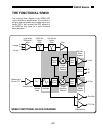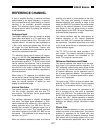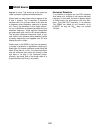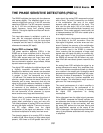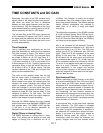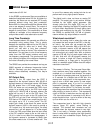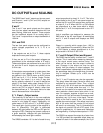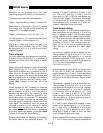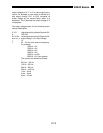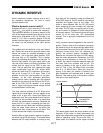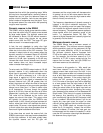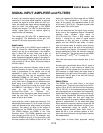
3-13
SR850 Basics
The SR850 has X and Y outputs on the rear panel
and Channel 1 and 2 (CH1 and CH2) outputs on
the front panel.
X and Y
The X and Y rear panel outputs are the outputs
from the two phase sensitive detectors with low
pass filtering, offset and expand. These outputs
are the traditional outputs of an analog lock-in.
The X and Y outputs have an output bandwidth of
100 kHz.
CH1 and CH2
The two front panel outputs can be configured to
output voltages proportional to X, Y, R, θ, or
Traces 1-4.
If the outputs are set to X or Y, these outputs
duplicate the rear panel outputs.
If they are set to R or θ the output voltages are
proportional to the calculated values of R and θ.
These calculations are performed at a rate of 512
Hz and the R and θ outputs are updated at the
512 Hz rate.
If the outputs are proportional to a data trace, then
the output is also updated at 512 Hz. The traces
are defined in the TRACE menu as A•B/C where
A,B,C can be X, Y, R, θ, Xnoise, Ynoise, Rnoise,
Frequency, Aux Inputs 1-4, or unity (C may also
be any quantity squared). If a trace is defined as
simply X, this trace, when output through CH1 or
CH2, will only update at 512 Hz. It is better in this
case to set CH1 to output X directly, rather than
the trace defined as X. The output scale of a data
trace is discussed later in this section.
X, Y, R and Output scales
The sensitivity of the lock-in is the rms amplitude
of an input sine (at the reference frequency) which
results in a full scale DC output. Traditionally, full
scale means 10 VDC at the X, Y or R BNC output.
The overall gain (input to output) of the amplifier is
then 10 V/sensitivity. This gain is distributed
between AC gain before the PSD and DC gain fol-
lowing the PSD. Changing the dynamic reserve at
a given sensitivity changes the gain distribution
while keeping the overall gain constant.
The SR850 considers 10 V to be full scale for any
output proportional to simply X, Y or R. This is the
output scale for the X and Y rear panel outputs as
well as the CH1 and CH2 outputs when configured
to output X, Y or R. When the CH1 or CH2 outputs
are proportional to a data trace which is simply
defined as X, Y or R, the output scale is also 10 V
full scale.
Lock-in amplifiers are designed to measure the
RMS value of the AC input signal. All sensitivities
and X, Y and R outputs and displays are RMS
values.
Phase is a quantity which ranges from -180° to
+180° regardless of the sensitivity. When the CH1
or CH2 outputs a voltage proportional to θ, the
output scale is 18°/Volt or 180°=10V.
X, Y and R Output Offset and Expand
The SR850 has the ability to offset the X, Y and R
outputs. This is useful when measuring deviations
in the signal around some nominal value. The
offset can be set so that the output is offset to
zero. Changes in the output can then be read
directly from the display or output voltages. The
offset is specified as a percentage of full scale and
the percentage does not change when the sensi-
tivity is changed. Offsets up to ±105% can be
programmed.
The X, Y and R outputs may also be expanded.
This simply takes the output (minus its offset) and
multiplies by an expansion factor. Thus, a signal
which is only 10% of full scale can be expanded to
provide 10 V of output rather than only 1 V. The
normal use for expand is to expand the measure-
ment resolution around some value which is not
zero. For example, suppose a signal has a nomi-
nal value of 0.9 mV and we want to measure small
deviations, say 10 µV or so, in the signal. The sen-
sitivity of the lock-in needs to be 1 mV to accom-
modate the nominal signal. If the offset is set so to
90% of full scale, then the nominal 0.9 mV signal
will result in a zero output. The 10 µV deviations in
the signal only provide 100 mV of DC output. If the
output is expanded by 10, these small deviations
are magnified by 10 and provide outputs of 1 VDC.
The SR850 can expand the output by a factor from
1 to 256 provided the expanded output does not
exceed full scale. In the above example, the 10 µV
DC OUTPUTS and SCALING



